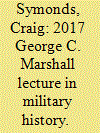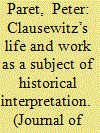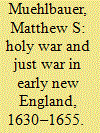|
|
|
Sort Order |
|
|
|
Items / Page
|
|
|
|
|
|
|
| Srl | Item |
| 1 |
ID:
154876


|
|
|
|
|
| Summary/Abstract |
Of all the various ways that American participation in World War II contributed to Allied victory, the most critical, and in the end the most decisive, was American industrial productivity, and particularly shipbuilding. United States ship construction between 1941 and 1945 dramatically outstripped both its own allies and all of its foes combined. The United States was not only the “arsenal of democracy” (Franklin Roosevelt’s phrase) but also the Allies’ shipbuilder, and superiority in shipping is what allowed the Allies to win the Battle of the Atlantic, conduct the D-Day invasion, and mount a simultaneous offensive in the Pacific.
|
|
|
|
|
|
|
|
|
|
|
|
|
|
|
|
| 2 |
ID:
154878


|
|
|
|
|
| Summary/Abstract |
In addition to being the first U.S. president, George Washington was a surveyor, a soldier, a planter, and the commander-in-chief of an army. All significant aspects of his life, these diverse roles involved interaction with weather conditions. More than simply part of the backdrop of Washington’s life, weather had a prominent role in shaping his experiences and the course of his career, both public and private. At times, the weather served as an ally by helping Washington in his pursuits, but most of the time, meteorological conditions were an adversary, inflicting hardships and disrupting or ruining his plans.
|
|
|
|
|
|
|
|
|
|
|
|
|
|
|
|
| 3 |
ID:
154883


|
|
|
|
|
| Summary/Abstract |
A new biography leads to reflections on different approaches to biography, and on the relationship of military history to the histories of ideas and of culture.
|
|
|
|
|
|
|
|
|
|
|
|
|
|
|
|
| 4 |
ID:
154882


|
|
|
|
|
| Summary/Abstract |
This article reexamines the intellectual origins, development, and operational execution of air-centric special operations theory during World War II. For over half a century, historians have offered conflicting narratives as to the origins, development, and initial execution of air-centric special operations theory. In light of newly uncovered historical evidence, this article concludes that each of the conflicting narratives falls significantly short of what the evidentiary record informs.
|
|
|
|
|
|
|
|
|
|
|
|
|
|
|
|
| 5 |
ID:
154880


|
|
|
|
|
| Summary/Abstract |
Enlisted soldiers of the U.S. Regular Army formed the bulk of America’s armed forces before the Civil War (1861–1865). A consensus has emerged that the prewar army’s enlisted men showed no divided loyalties and only twenty-six served in the Confederate Army; but the army’s enlisted soldiers, just like its officers, reacted to the Civil War in varying ways. An analysis of desertion during the secession crisis and first months of the war reveals that many soldiers were just as conflicted as the officer corps. Evidence suggests more than 500 Regular Army soldiers “went South” and served in the Confederate Army.
|
|
|
|
|
|
|
|
|
|
|
|
|
|
|
|
| 6 |
ID:
154877


|
|
|
|
|
| Summary/Abstract |
New England’s leaders employed Western Christian concepts of holy war and just war to address regional crises between 1630 and 1655. Ex post facto attempts to justify the destruction of Mystic village during the Pequot War (1636–37) relied on holy war ideas. But other episodes, including attempts to avoid war, as well as the founding of the United Colonies of New England, demonstrated just war tenets. This essay will examine the use and misuse of these concepts, including during the First Anglo-Dutch War (1652–54), when disputes over a potential attack on New Netherland almost destroyed the alliance.
|
|
|
|
|
|
|
|
|
|
|
|
|
|
|
|
| 7 |
ID:
154881


|
|
|
|
|
| Summary/Abstract |
During the first decade of the twenty-first century, defense analysts identified the emergence of “hybrid warfare” as a compelling threat to American national security. Generally speaking, hybrid warfare consists of “conflict involving a combination of conventional military forces and irregulars … which could include both state and non-state actors, aimed at achieving a common political purpose.” This paper uses as a case study of hybrid warfare a specific campaign in the U.S. Civil War where conventional and unconventional operations were significant factors. It considers Maj. Gen. Philip Sheridan’s efforts to defeat the Confederate hybrid threat in Virginia’s Shenandoah Valley, the particular dynamics and challenges he confronted, and the factors that enabled him to prevail. By doing so, it will both draw on and contribute to the growing body of literature on the campaign and the challenge of countering hybrid warfare.
|
|
|
|
|
|
|
|
|
|
|
|
|
|
|
|
| 8 |
ID:
154879


|
|
|
|
|
| Summary/Abstract |
At the outset of the American Revolution (April 1775), the revolutionaries were unprepared for the challenges of civil war. How would they treat those Americans who remained loyal to Britain? Initially, the Revolutionary leadership strove to conduct the war according to European customs that stressed the humane treatment of enemy prisoners. But in the months following the Declaration of Independence (July 1776), they began to re-imagine loyalists as rebels and traitors. This re-conceptualization had dire consequences for loyalist prisoners in their hands. No longer shielded by the humane conventions of Enlightenment warfare, loyalists were subject to violence scarcely imaginable when the conflict began.
|
|
|
|
|
|
|
|
|
|
|
|
|
|
|
|
|
|
|
|
|